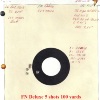There was a time when vernier calipers were expensive and dial calipers were super expensive. I think I paid the equivalent of $210.00 in today's money for a Sears Craftsman vernier. It took forever to read the OAL of fired cartridges.

I had to then get a magnifying glass to read the vernier.

Being lazy, and time pressed, I came up with a theory that first time cases did not need trimming. This was not created by measuring the length of first time fired cases, oh no, that would have taken too much time! Well it turns out factory new, first time fired rifle cases "grow" more than second time fired cases. Factory cases have a lot of clearance in the chamber, as that helps in feeding and extraction, and I think that is the reason they "grow" more in length when fired in the mostly, but not exactly SAAMI chambers in my rifles.
So, I found out the hard way, by experiencing blown primers, that it was important to trim cases, to keep the case necks out the the chamber throats. When both the bullet and case neck are in the throat. the bullet is pinched, pressures rise, bad things happen.
However, under length? I have vastly untrimmed rifles cases when setting up my Giraud and Gracey case trimmers. I purchased a Gracey direct from Col Gracey when he sold trimmers at Camp Perry. He was a interesting and enthusiastic salesman. He could sell horse shoes to a shod horse.
These case trimmers are trial and error, and the 223, 308, 30-06 that I trimmed, occasionally, cases would come out 0.010 less than minimum OAL. And, my 270 Win cases, made by neck sizing 30-06 cases, are well below 270 Win minimum. And they all go bang, and they all shoot well.

a bit low, only needed to adjust the sights

I am of the opinion, that a little short is a big nothing burger. Maybe for someone shooting my 300 yard groups at 1000 yards, maybe they will see something. They might even see the affect of gravitational differences across hills and valleys, but not within my hold.
As long as the case is long enough, and strong enough to hold the bullet in place, the round will go bang, the bullet will go down range, and life will be good. I do try to stay above case minimums when trimming. I do know case neck length can vary out of the sizing die, by differences in case lube thickness !
I do think important, is base to shoulder length. I try to have the case shoulder average 0.003" from the rifle chamber, to ensure each round chambers effortlessly. However I do have a couple of 35 Whelen rifles which have misfired or hangfired (in cold weather) due to too much clearance between case and chamber. The 35 Whelen has a very shallow, yet highly tapered shoulder,


and it is easy to dissipate firing pin energy on this case by essentially, sizing the case down when the firing pin hits the primer. So for the 35 Whelen, I make sure all my cases have zero clearance to a tiny bit of crush when the bolt is closed.
I note that the recent, stubby, high performance cartridges, all have very abrupt shoulders. The older case designers were more concerned with perfect feeding and extraction from the magazine. Highly tapered rounds feed and extract much better than straight walled cases. However, today everything is single stack.

and the long range shooters are using single shot actions without ejectors! So they can live with cases that are straight, and have abrupt shoulders for better ignition.








